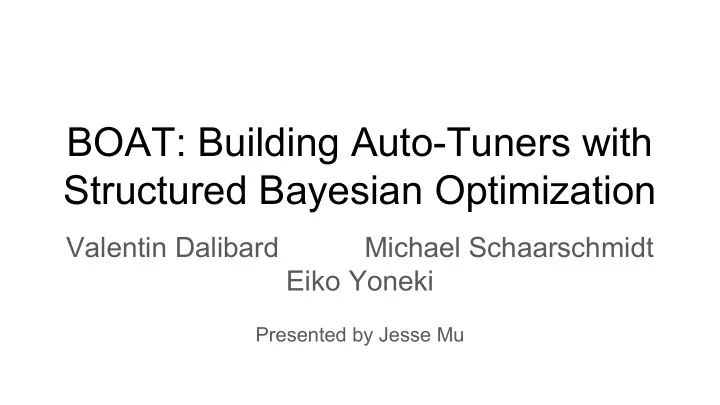

BOAT: Building Auto-Tuners with Structured Bayesian Optimization Valentin Dalibard Michael Schaarschmidt Eiko Yoneki Presented by Jesse Mu
Parameters in large-scale systems Coarse Number of cluster nodes ML Hyperparams Compiler Flags Fine
Parameters in large-scale systems Coarse How to optimize Number of cluster nodes parameters θ ? ML Hyperparams Compiler Flags Fine
Parameters in large-scale systems Coarse How to optimize Number of cluster nodes parameters θ ? Minimize some cost ML Hyperparams function f( θ ) . Compiler Flags Fine
Parameters in large-scale systems Coarse How to optimize Number of cluster nodes parameters θ ? Minimize some cost ML Hyperparams function f( θ ) ...where cost is runtime, Compiler Flags Fine memory, I/O, etc
Auto-tuning (optimization)
Auto-tuning (optimization) Grid search θ ∈ [1, 2, 3, …] ●
Auto-tuning (optimization) θ ∈ [1, 2, 3, …] ● Grid search ● Evolutionary approaches (e.g. ) ● Hill-climbing (e.g. )
Auto-tuning (optimization) θ ∈ [1, 2, 3, …] ● Grid search ● Evolutionary approaches (e.g. ) ● Hill-climbing (e.g. ) SPEARMINT ● Bayesian optimization (e.g. )
Auto-tuning (optimization) in distributed systems θ ∈ [1, 2, 3, …] ● Grid search ● Evolutionary approaches (e.g. ) ● Hill-climbing (e.g. ) SPEARMINT ● Bayesian optimization (e.g. )
Auto-tuning (optimization) in distributed systems θ ∈ [1, 2, 3, …] ● Grid search ● Evolutionary approaches (e.g. ) Require 1000s of evaluations of ● Hill-climbing (e.g. ) cost function! SPEARMINT ● Bayesian optimization (e.g. )
Auto-tuning (optimization) in distributed systems θ ∈ [1, 2, 3, …] ● Grid search ● Evolutionary approaches (e.g. ) Require 1000s of evaluations of ● Hill-climbing (e.g. ) cost function! Fails in high SPEARMINT ● Bayesian optimization (e.g. ) dimensions!
Auto-tuning (optimization) in distributed systems θ ∈ [1, 2, 3, …] ● Grid search ● Evolutionary approaches (e.g. ) Require 1000s of evaluations of ● Hill-climbing (e.g. ) cost function! Fails in high SPEARMINT ● Bayesian optimization (e.g. ) dimensions! ● Structured Bayesian optimization (this work: B esp O ke A uto- T uners)
Gaussian Processes Data Prior Posterior From Carl Rasmussen’s 4F13 lectures http://mlg.eng.cam.ac.uk/teaching/4f13/1718/gp%20and%20data.pdf
e.g. expected increase over max perf. (balance exploration vs exploitation)
Bayesian Optimization Gaussian Process
Structured Bayesian Optimization (SBO) Gaussian Process
Structured Bayesian Optimization (SBO)
Structured Bayesian Optimization (SBO) * *Developer-specified, semi-parametric model of performance from observed performance + arbitrary runtime characteristics
Structured Bayesian Optimization (SBO) * *Developer-specified, semi-parametric model of performance from observed performance + arbitrary runtime characteristics
Probabilistic Models for SBO
Probabilistic Models for SBO
Probabilistic Models for SBO Too restrictive Too generic Just right
Semi-parametric models in SBO ● Specify the parametric component only (GP for free)
Semi-parametric models in SBO ● Specify the parametric component only (GP for free) ● e.g. predict GC rate from JVM eden size
Semi-parametric models in SBO ● Specify the parametric component only (GP for free) ● e.g. predict GC rate from JVM eden size
Semi-parametric models in SBO ● Specify the parametric component only (GP for free) ● e.g. predict GC rate from JVM eden size Prior: malloc rate ~ Uniform(0, 5000)
Semi-parametric models in SBO
Composing semi-parametric models
Composing semi-parametric models
Composing semi-parametric models Dataflow DAG Inference exploits conditional independence between models
Composing semi-parametric models Dataflow DAG Inference exploits conditional independence between models
SBO: Summary 1. Configuration space (i.e. possible params) 2. Objective function + runtime measurements 3. Semi-parametric model of system
SBO: Summary 1. Configuration space (i.e. possible params) standard 2. Objective function + runtime measurements 3. Semi-parametric model of system
SBO: Summary 1. Configuration space (i.e. possible params) standard 2. Objective function + runtime measurements 3. Semi-parametric model of system new
SBO: Summary 1. Configuration space (i.e. possible params) standard 2. Objective function + runtime measurements 3. Semi-parametric model of system new Key: try generic system, before optimizing with structure
Evaluation: Cassandra GC
Evaluation: Cassandra GC
Evaluation: Cassandra GC Best params outperform Cassandra defaults by 63% Existing systems converge but take 6x longer
Evaluation: Neural Net SGD Load balancing, worker allocation over 10 machines = 30 params
Evaluation: Neural Net SGD Load balancing, worker allocation over 10 machines = 30 params
Evaluation: Neural Net SGD Load balancing, worker allocation over 10 machines = 30 params Default configuration: 9.82s OpenTuner: 8.71s BOAT: 4.31s Existing systems don’t converge!
Review:
Review: overall, a good, unsurprising contribution
Review: overall, a good, unsurprising contribution ● Theory ○ Unsurprising that expert-developed models optimize better! ■ Tradeoff: developer hours vs machine hours ○ Cassandra GC system converges in 2 iterations - model is near-perfect! What happens when parametric model is wrong? ■ More details about tradeoff between parametric model and generic GP ■ OpenTuner: build an ensemble of multiple search techniques
Review: overall, a good, unsurprising contribution ● Theory ○ Unsurprising that expert-developed models optimize better! ■ Tradeoff: developer hours vs machine hours ○ Cassandra GC system converges in 2 iterations - model is near-perfect! What happens when parametric model is wrong? ■ More details about tradeoff between parametric model and generic GP ■ OpenTuner: build an ensemble of multiple search techniques ● Implementation ○ Cross-validation? ○ Key for system adoption: make interface as high-level as possible
Review: overall, a good, unsurprising contribution ● Theory ○ Unsurprising that expert-developed models optimize better! ■ Tradeoff: developer hours vs machine hours ○ Cassandra GC system converges in 2 iterations - model is near-perfect! What happens when parametric model is wrong? ■ More details about tradeoff between parametric model and generic GP ■ OpenTuner: build an ensemble of multiple search techniques ● Implementation ○ Cross-validation? ○ Key for system adoption: make interface as high-level as possible ● Evaluation ○ What happens when # params >> 30? ○ “DAGModels help debugging”...how?
Recommend
More recommend